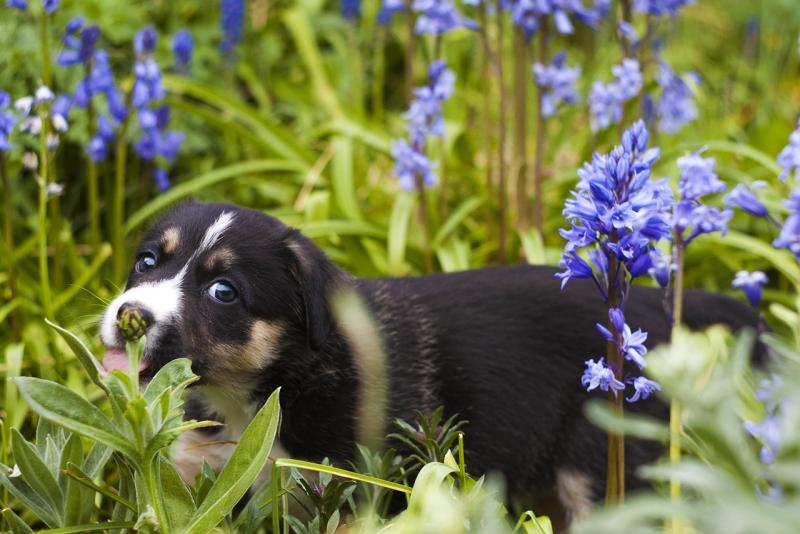Sarah Browning, Nebraska Extension Educator

Be sure the plants in your landscape are not toxic to dogs. Image by Pixabay.com
According to the Humane Society of the United States, over 69 million or 54% of American households own a dog and 85% of those pet owners view their dogs as family members or companions. So naturally dog owners want their landscapes to be a safe place for their companions.
A Healthy Lawn
Lawns get a bad rap as water-hogs requiring large amounts of fertilizer and pesticides to keep them healthy. But a well-maintained lawn is actually one of the best ground covers around, providing a great place to play and rest in the shade. And it doesn’t have to be a fertilizer and pesticide sink. Tall fescue should be the turfgrass choice for pet owners, for the following reasons.
- During a summer with normal precipitation, tall fescue lawns require very little (if any) irrigation.
- Tall fescue is more durable under heavy paw-traffic than Kentucky bluegrass.
- Fewer disease problems, which means less chance you’ll ever need to apply a fungicide.
- Very seldom troubled by white grubs, which eliminates the need for insecticide applications.
Keep your lawn healthy and thick, which also minimizes the need for weed control products, by overseeding in fall. If your lawn becomes thin due to digging or heavy traffic the prime time for overseeding tall fescue lawns is now – August 15th through September 15th. Aerating is a great way to prepare the thin spots for overseeding.
More information on good lawn care practices.
- Improving Turf in the Fall, Turfgrass iNfo
- Cool Season Lawn Calendar for Eastern Nebraska, Turfgrass iNfo
Use Non-Toxic Plants
Unfortunately, there is a long list of plants toxic to dogs, including many bulbs like naked ladies, Asiatic lilies and tulips, as well as trees, shrubs, weeds and mushrooms. If your dog is likely to chew plants, don’t forget tropical plants in containers on your deck or patio as a potential threat. Visit the American Society for the Prevention of Cruelty to Animals’ (ASPCA) website for a complete list. The easiest way to evaluate your current landscape would be to make a list of plants and check them again the ASPCA list.
When mushrooms appear in your garden, pick and discard them. Don’t allow your dogs access to your compost pile, where they may find toxic plants and be tempted to chew on them.

Choose Non-Toxic Products
Look for fertilizer and pesticide options that minimize risks to your four-legged friends.
For control of pest problems, identify the pest first then choose the least toxic method of control. For example, pests like aphids and spider mites can be reduced with a strong spray of water or an application of horticultural oil, rather than a traditional insecticide. Bagworms can be controlled with a biological product called Dipel or Thuricide; a bacteria which kills the larvae of moths but is very safe for humans, pets and wildlife.
Use wood chips or a similar mulch to minimize weed problems in landscape beds. Mulch used in combination with a preemergence herbicide gives the best weed control. But stay away from cocoa bean hulls as a mulch. Although they smell great, they contain theobromine which is toxic to dogs.
Spend a couple hours in your gardens each week throughout the summer hoeing or pulling any weeds that appear. This eliminates the need for post emergent herbicides. Plus, it's a great way to get outside with your dogs and enjoy a quiet summer evening.
Corn Gluten Meal
Consider using corn gluten meal as your preemergent weed control product – it provides two benefits in hands of animal-loving gardeners. First, it can be used as an organic fertilizer for your lawn or landscape plantings. Second, it also works as a preemergence herbicide to kill germinating weed seeds, yet is safe for you, your dog and wildlife. Look for it in products like Preen Organic, Concern and Wow.
Corn gluten meal contains about 10% nitrogen by weight. Nick Christians, Iowa State Professor of Horticulture, recommends 20 lbs. of product applied per 1,000 sq.ft. This supplies about 1 lb. of nitrogen per 1,000 sq.ft., which equals about one of the fertilizer applications normally recommended for lawns. Corn gluten meal is a slow-release form of nitrogen, providing nutrients over a 3-4 month period after application. This can be a benefit to gardeners, since it eliminates the risk of burning your lawn with an overapplication of nitrogen.
The same application rate is also recommended for lawn weed control. But remember, preemergence herbicides, like corn gluten meal, will not kill any existing weeds. They only kill newly germinating weed seeds. So they must be applied before weeds begin to germinate.
Image by Pixabay.com